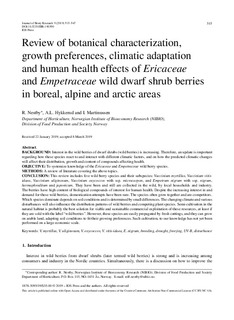| dc.contributor.author | Nestby, Rolf | |
| dc.contributor.author | Hykkerud, Anne Linn | |
| dc.contributor.author | Martinussen, Inger | |
| dc.date.accessioned | 2020-01-13T10:06:22Z | |
| dc.date.available | 2020-01-13T10:06:22Z | |
| dc.date.created | 2019-09-30T14:00:10Z | |
| dc.date.issued | 2019-08-28 | |
| dc.identifier.citation | Journal of Berry Research. 2019, 9 (3), 515-547. | nb_NO |
| dc.identifier.issn | 1878-5093 | |
| dc.identifier.uri | http://hdl.handle.net/11250/2635896 | |
| dc.description.abstract | BACKGROUND: Interest in the wild berries of dwarf shrubs (wild berries) is increasing. Therefore, an update is important regarding how these species react to and interact with different climatic factors, and on how the predicted climatic changes will affect their distribution, growth and content of compounds affecting health. OBJECTIVE: To systemize knowledge of the Ericaceae and Empetraceae wild berry species. METHODS: A review of literature covering the above topics. CONCLUSION: This review includes five wild berry species and their subspecies: Vaccinium myrtillus, Vaccinium vitis-idaea, Vaccinium uliginosum, Vaccinium oxycoccos with ssp. microcarpon, and Empetrum nigrum with ssp. nigrum, hermaphroditum and japonicum. They have been and still are collected in the wild, by local households and industry. The berries have high content of biological compounds of interest for human health. Despite the increasing interest in and demand for these wild berries, domestication attempts have been rare. The species often grow together and are competitors. Which species dominate depends on soil conditions and is determined by small differences. The changing climate and various disturbances will also influence the distribution patterns of wild berries and competing plant species. Semi-cultivation in the natural habitat is probably the best solution for viable and sustainable commercial exploitation of these resources, at least if they are sold with the label “wild berries”. However, these species are easily propagated by fresh cuttings, and they can grow on arable land, adapting soil conditions to fit their growing preferences. Such cultivation, to our knowledge has not yet been performed on a large economic scale. | nb_NO |
| dc.language.iso | eng | nb_NO |
| dc.rights | Attribution-NonCommercial-NoDerivatives 4.0 Internasjonal | * |
| dc.rights.uri | http://creativecommons.org/licenses/by-nc-nd/4.0/deed.no | * |
| dc.subject | V. myrtillus | nb_NO |
| dc.subject | V. uliginosum | nb_NO |
| dc.subject | V. oxycoccos | nb_NO |
| dc.subject | V. vitis-idaea | nb_NO |
| dc.subject | E. nigrum | nb_NO |
| dc.subject | breeding | nb_NO |
| dc.subject | drought | nb_NO |
| dc.subject | freezing | nb_NO |
| dc.subject | UV-B | nb_NO |
| dc.subject | disturbance | nb_NO |
| dc.title | Review of botanical characterization, growth preferences, climatic adaptation and human health effects of Ericaceae and Empetraceae wild dwarf shrub berries in boreal, alpine and arctic areas | nb_NO |
| dc.type | Journal article | nb_NO |
| dc.type | Peer reviewed | nb_NO |
| dc.description.version | publishedVersion | nb_NO |
| dc.rights.holder | © 2019 – IOS Press and the authors | nb_NO |
| dc.subject.nsi | VDP::Landbruks- og Fiskerifag: 900 | nb_NO |
| dc.source.pagenumber | 515-547 | nb_NO |
| dc.source.volume | 9 | nb_NO |
| dc.source.journal | Journal of Berry Research | nb_NO |
| dc.source.issue | 3 | nb_NO |
| dc.identifier.doi | 10.3233/JBR-190390 | |
| dc.identifier.cristin | 1731525 | |
| cristin.unitcode | 7677,1,0,0 | |
| cristin.unitname | Divisjon for matproduksjon og samfunn | |
| cristin.ispublished | true | |
| cristin.fulltext | original | |
| cristin.qualitycode | 1 | |

